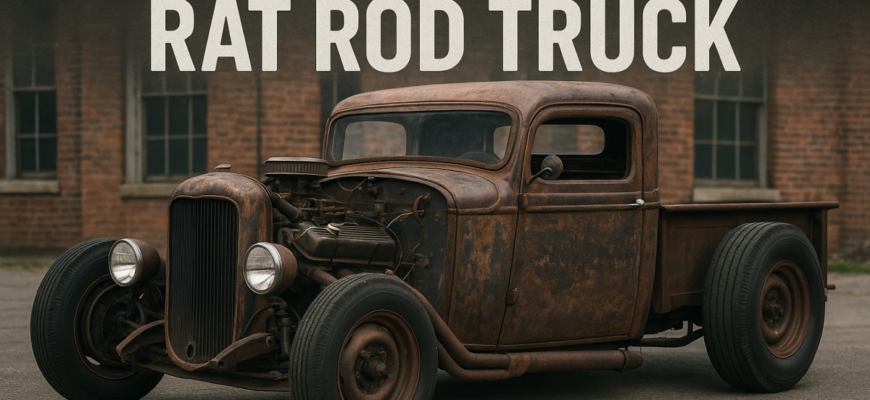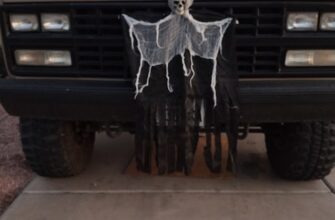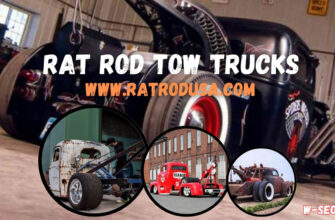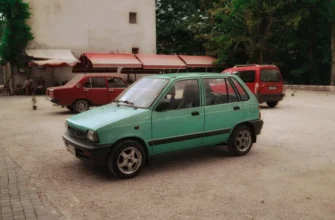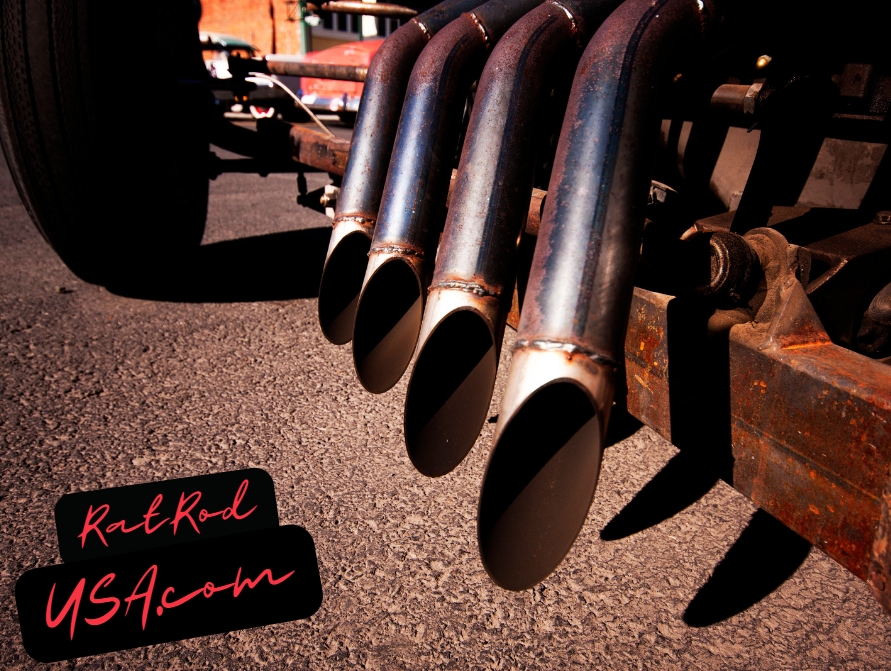There exists a paradox in the world of automotive craftsmanship. While the majority chase perfection in polished chrome, flawless paint, and gleaming surfaces, a select few find their calling in the exact opposite. They see beauty not in what has been added, but in what has been stripped away. Their canvas is rust, their palette is patina, and their ultimate goal is not a show-car, but a statement—a living, breathing testament to defiance, history, and raw mechanical poetry. This is the world of the rat rod truck, a culture that challenges our very notions of what is considered “perfect.” It is a journey into the soul of a machine, where character trumps convention and every dent tells a story. Building one is not just a technical endeavor; it’s a profound act of creation, a psychological release from the pressure of perfection, and a direct line to the heart of what makes a vehicle truly great. It is a rebellion on four wheels, and it begins with a single, courageous decision: to embrace the imperfect.
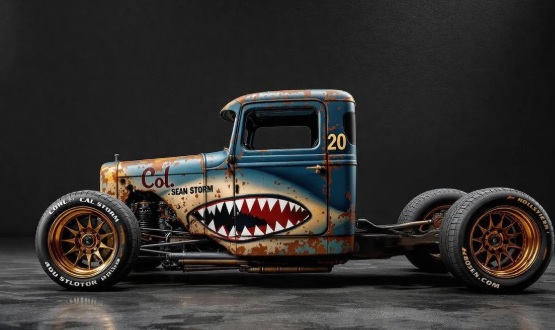
The Vision: Finding the Soul of Your Project
The first and most critical step in building a rat rod is not technical; it’s existential. You must disconnect from the conventional wisdom that dictates what a vehicle “should” be. A rat rod truck is a reflection of its builder’s personality, and a flawless build is a contradiction in terms. This isn’t about following a blueprint; it’s about listening to the vehicle itself. The rust on that ’51 Ford F1 might be a map of its life—a ghost of every rainstorm it endured, every dusty backroad it traversed. To sandblast it clean is to erase its history. The art lies in preserving this narrative while making the vehicle a functional, safe, and powerful machine.
Your vision will be guided by two core principles: form and function. The “form” is the aesthetic, the deliberate decision to keep the patina, the exposed welds, the mismatched parts. This is where you make a psychological break from the norm. You are choosing to celebrate imperfection, which is a surprisingly liberating act. Psychologically, this approach reduces the immense pressure that comes with a high-stakes, flawless build. There is no anxiety over a scratch or a chip; they are simply part of the evolving story. The “function” is the mechanical heart of the truck. While the exterior might look like it just rolled out of a forgotten field, the engine, suspension, and brakes must be meticulously engineered and flawless. This contrast is the essence of the rat rod. A rusty, seemingly ramshackle exterior hiding a precisely tuned, modern powertrain is a powerful statement about substance over superficiality.
The search for your canvas is a treasure hunt. You’ll likely find it in a barn, a forgotten field, or on a classified ad far from a major city. The most compelling rat rods begin with a vehicle that has a story—a classic body from the 1930s, 40s, or 50s that has been weathered by time. Look for a strong cab and frame, but don’t worry about missing doors, shattered glass, or dents. These are not flaws; they are character-defining features waiting to be incorporated into your design. This initial selection phase is a deeply personal journey, a search not just for a vehicle, but for an emotional connection to a piece of history.
The Mechanical Metamorphosis: Combining Old Bones with New Muscle
Once you have your foundation, the real work begins—the mechanical transformation that turns a derelict shell into a road-worthy beast. This is where the meticulous, scientific side of the build comes to the forefront. The first step is to strip the chassis down to its bare frame. This allows for a complete assessment of its structural integrity. While the body may be left to its rustic charm, the frame must be sound, or it must be reinforced. Welding and reinforcing the frame is a critical safety step that cannot be overlooked.
With the frame prepped, the next major decision is the powertrain. A common practice is to “hot-rod” the truck with a powerful, modern engine—often a Chevy small-block V8, a Ford 302, or a more contemporary LS engine. This choice is where the psychological release of the “rat rod” concept truly shines. While purists might insist on a period-correct engine, a rat rodder sees an opportunity for uninhibited power and reliability. An engine that offers a fantastic power-to-weight ratio and a wide availability of aftermarket parts is the ideal choice. The goal is to create a vehicle that is thrilling to drive, a wolf in sheep’s clothing. This juxtaposition of a rough exterior with a high-performance heart is a powerful symbol of inner strength and unexpected potential. It’s a message that what truly matters is not on the surface.
The suspension and braking systems are equally crucial. A rat rod is often built with an independent front suspension (IFS) from a donor car or a custom-fabricated four-link system in the rear. This provides modern handling and a much-needed level of safety that the original leaf springs simply cannot offer. The brakes must also be upgraded, typically to discs on all four wheels, to handle the increased power. This is where the builder’s integrity is on full display. A true rat rod is not a dangerous junk pile; it is a carefully engineered machine where every mechanical component is installed with precision and care. It’s a testament to the fact that form doesn’t have to compromise function.
The Final Touch: Patina, Psychology, and a Story Told in Steel
As the mechanical components come together, the focus shifts to the aesthetic. This is the stage where you lean into the very core of the rat rod philosophy. The most important rule? Do not paint it. The patina—the natural aging, rust, and fading of the original metal—is your finish. It is the signature of time, the irreplaceable texture that gives the truck its soul. To protect this patina, you can apply a clear coat or even a wax to prevent further rust, preserving the vehicle’s “found” character. This act is not about preservation in the traditional sense, but about celebrating the vehicle’s natural state. It’s a lesson in finding beauty in decay and imperfection.
The final details are what transform a vehicle into a masterpiece. A rat rod is often low, with the body sitting close to the pavement, a stance achieved through a process called “channeling” or “dropping.” This low-slung profile creates an aggressive, almost predatory look. Mismatched parts, from old-school grilles to unusual headlights, contribute to the unique character. A truly great rat rod is like a scrapbook of parts from different eras, each one contributing a small piece to the greater narrative. This is where the builder’s creativity and sense of humor can truly shine. An old license plate for a dashboard, a gearshift knob made from a wrench, or even a beer keg for a fuel tank—these details are personal signatures that make the truck one of a kind.
Building a rat rod is a journey of self-discovery. It forces you to confront the ingrained cultural obsession with “new and shiny” and to find value in the things that others discard. It’s a reminder that authenticity is far more compelling than polished artifice. Each bolt you tighten, each weld you lay, is an investment in a machine that is authentically yours. There is no template, no manual to follow step-by-step. The path is yours to forge, and the destination is not a show trophy, but the deep satisfaction of knowing you built something genuine, something that tells a story and defies easy categorization.
The rat rod truck, in its essence, is a powerful metaphor for life itself. We spend so much time and energy trying to be perfect, to present a flawless, polished version of ourselves to the world. We hide our scars, our mistakes, our moments of vulnerability, believing that they diminish our value. Yet, a rat rod shows us that our history, our imperfections, and our raw, unvarnished experiences are precisely what give us character and depth. It’s a powerful invitation to embrace our own rust, our own dents and dings, and to recognize that true strength lies not in erasing our past, but in owning it. The perfect rat rod is not built; it is revealed. It’s a living testament to the beauty of a life well-lived, a machine that challenges us all to look beyond the surface and to find the extraordinary in the everyday, the beautiful in the broken, and the profound in the unfinished. It is a call to create, to dare, and to build something not just for others to admire, but for your own soul to inhabit.
Submit your RAT ROD project to office at ratrodusa dot com!
(10)

